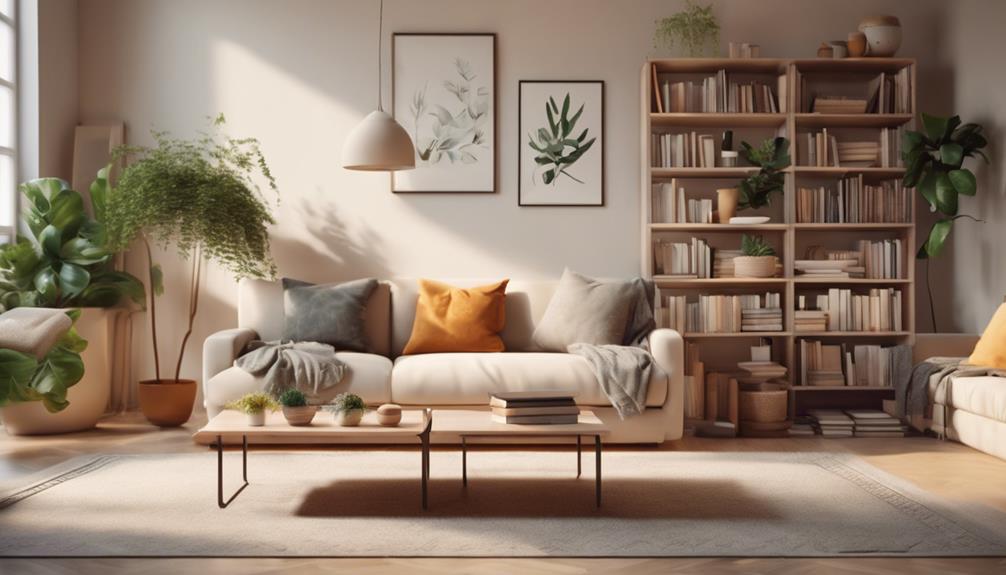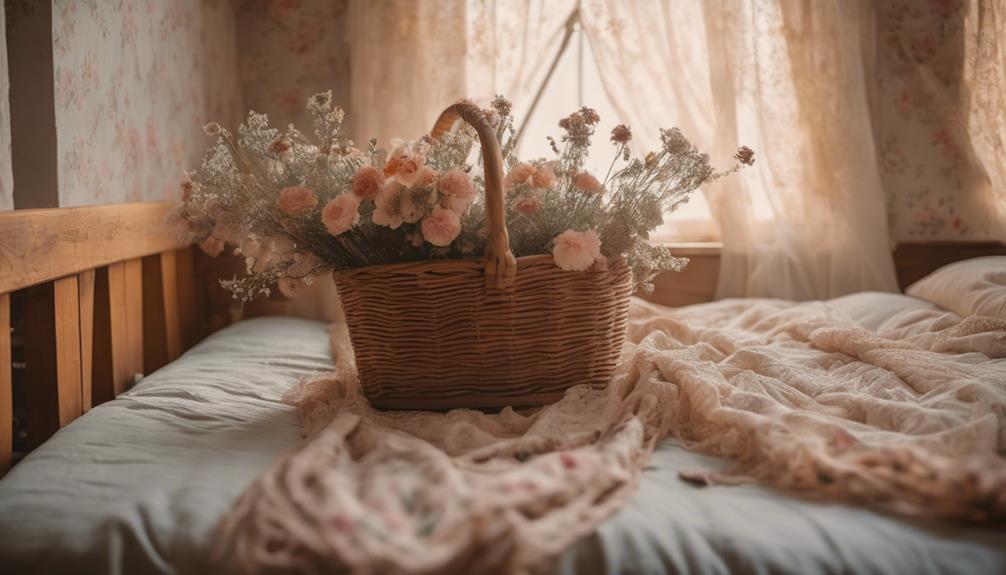When you're choosing between wool and linen for Scandinavian textiles, consider your climate and comfort needs. Wool's warmth and moisture-wicking properties make it perfect for colder weather, while linen's lightweight texture suits hot climates. Both materials are durable and showcase the minimalist style of Nordic design. Wool adds coziness, ideal for rustic spaces, while linen lends a crisp elegance to your decor. Think about how each fabric's unique qualities will complement your furniture and lighting choices. There's more to explore about the textures and aesthetics that define these materials, helping you make the best choice for your space.
Key Elements
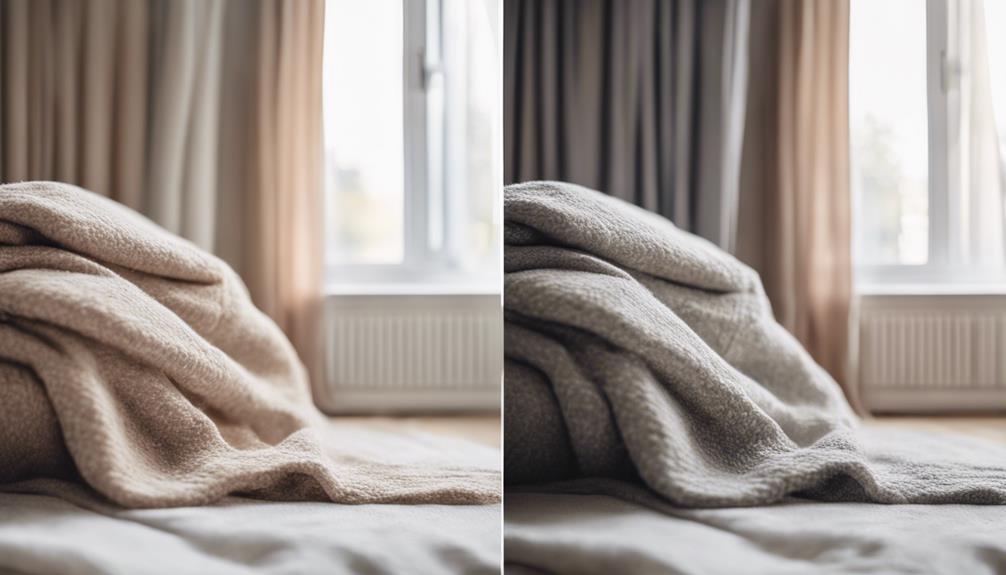
When choosing between wool and linen, consider the color schemes you want to incorporate into your space or wardrobe.
Both materials offer unique textures and a range of colors, allowing you to express your personal style.
Understanding the characteristics of each can help you make a more informed decision for your textile needs.
Color Scheme
In Scandinavian textiles, a natural color palette featuring shades of brown, red, and blue enhances the connection to the region's landscapes and traditional weaving practices. When you choose wool products, these colors reflect the earthiness and simplicity of the Nordic environment.
Historically, wool textiles were primarily brown, as white wool was a rarity, which shaped the color choices in weaving. This preference for solid colors aligns with the minimalist aesthetic that Scandinavian design embodies today.
You'll notice that modern textiles continue this trend, often opting for geometric patterns in muted tones. The use of organic dyes was limited in the past, leading artisans to embrace hues that harmonized with their surroundings.
This practice results in a subdued yet striking color scheme that complements various interior styles.
Materials
Scandinavian textiles rely on key materials like wool and linen, each offering distinct qualities that cater to different needs and climates.
Linen, derived from the flax plant, is one of the strongest natural fibers, capable of lasting decades when cared for properly. It absorbs up to 20% of its weight in moisture, making it highly breathable and ideal for hot climates. This makes linen a popular choice for lighter, summer apparel.
On the other hand, wool mainly comes from sheep and provides natural insulation, making it essential for warmth in colder weather. Wool excels in moisture-wicking, keeping you dry and warm even in damp conditions. Its natural elasticity adds to its durability and comfort against your skin.
Both materials showcase sustainability attributes: linen requires a labor-intensive production process, while wool is sourced from various animals, largely sheep. Linen is also naturally hypoallergenic and antibacterial, softening with wear, which adds to its appeal.
When choosing between linen and wool, consider the climate and your specific needs, as each material brings unique benefits that enhance your Scandinavian textile experience.
Textures
Linen's crisp, relaxed texture contrasts beautifully with wool's soft, cozy feel, making each textile uniquely suited for different applications and preferences. When you're choosing between linen and wool, consider how their textures affect your comfort and style.
Linen's lightweight, breathable nature is perfect for hot climates, allowing air to flow freely. This means you can wear linen comfortably during the summer without feeling overheated.
On the other hand, wool provides natural insulation, keeping you warm in cooler temperatures. Its soft texture adapts to your body temperature, offering comfort whether you're indoors or out.
While linen can feel crisp and a bit stiff initially, it softens with time, developing a relaxed elegance that many love. However, keep in mind that pure linen wrinkles easily, which mightn't suit everyone's taste for a polished look.
Wool, in contrast, resists wrinkling, maintaining a neat appearance even after several wears. Ultimately, your choice between linen and wool will depend on your climate, lifestyle, and personal preference for texture and comfort.
Essential Fixtures and Furniture
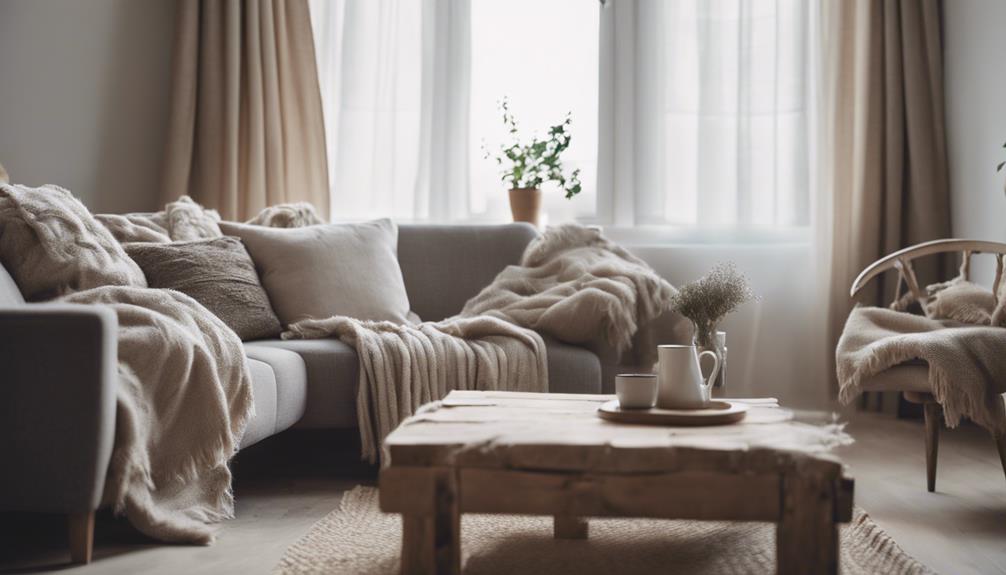
When choosing essential fixtures and furniture, think about how wool and linen can enhance your space.
A rustic wooden dining table paired with a handcrafted linen table runner creates a warm yet stylish setting, while a vintage wool wall hanging adds texture and character.
These elements work together to embody the cozy, functional aesthetic of Scandinavian design.
Rustic Wooden Dining Table
Have you considered how a rustic wooden dining table can transform your dining space into a warm and inviting gathering spot? These tables are often crafted from solid hardwoods like oak, pine, or walnut, ensuring durability while showcasing the natural beauty of the wood grain. The imperfections and textures highlight the table's character, making it a centerpiece that draws family and friends together.
Typically designed in a farmhouse style, rustic wooden dining tables feature sturdy construction with chunky legs and a distressed or reclaimed appearance. You can find sizes that accommodate anywhere from four to twelve or more people, perfect for family dinners or festive gatherings.
To enhance your rustic dining experience, consider pairing your table with quality linen tablecloths and napkins. High-quality linen not only adds a touch of elegance but also complements the natural aesthetic of the wood.
Maintaining your rustic wooden dining table is straightforward: regular oiling or waxing will protect the surface and prolong its life while preserving its charm. By investing in a rustic wooden dining table, you're creating a space that fosters connection and shared memories.
Handcrafted Linen Table Runner
A handcrafted linen table runner can beautifully complement your rustic wooden dining table, enhancing its charm while adding a touch of elegance to your dining experience.
Linen's durability means this table runner can last for decades with proper care, making it an eco-friendly choice that aligns with your sustainable lifestyle.
Moreover, linen is highly breathable and moisture-absorbent, ensuring it maintains a fresh appearance during warm gatherings or meals. The labor-intensive production process, which includes retting, cleaning, and weaving, gives linen its unique texture and quality, making each piece special.
You'll often find linen table runners featuring natural and botanical themes, perfectly reflecting Scandinavian design principles that prioritize simplicity and a connection to nature.
Additionally, being naturally hypoallergenic and antibacterial, linen table runners offer a healthy dining option that enhances both aesthetics and practicality in your home.
Vintage Wool Wall Hanging
Vintage wool wall hangings add warmth and texture to your space, showcasing the timeless beauty of traditional Scandinavian craftsmanship. These pieces are often crafted using traditional weaving techniques like tabby and twill, reflecting the enduring artistry that defines Scandinavian textile design. The natural insulating properties of wool make vintage wool wall hangings an ideal choice, as they provide both visual appeal and a cozy atmosphere in your home.
You'll find that many vintage wool wall hangings feature geometric patterns and nature-inspired motifs, which are characteristic of Scandinavian aesthetics that emphasize simplicity and functionality. Their durability guarantees that these hangings can withstand the test of time, becoming treasured items that last for decades with proper care.
The rich, earthy tones derived from natural sheep wool enhance the inviting ambiance commonly associated with Scandinavian design. By incorporating vintage wool wall hangings into your decor, you not only elevate your space but also celebrate a tradition that values craftsmanship and quality.
Lighting Ideas

When you're choosing lighting for spaces featuring wool and linen textiles, think about how pendant lights can add a warm glow.
Soft table lamps and candlelit lanterns can enhance the cozy atmosphere you're aiming for, while chic Scandinavian floor lamps can provide both function and style.
These lighting options not only illuminate your space but also highlight the beauty of your textiles.
Hanging Pendant Lights With Warmth
Hanging pendant lights can transform your space by adding warmth and inviting ambiance with the right bulb choices and materials.
Opt for warm-toned bulbs with a color temperature between 2700K and 3000K, as these emit a soft, cozy glow that enhances the overall atmosphere. When selecting pendant lights, consider designs that incorporate natural materials like wood, rattan, or linen shades. These elements resonate with Scandinavian design principles, creating a sense of comfort and coziness.
Adjustable pendant lights are another great option. They allow you to customize height settings, giving you the flexibility to create layered lighting effects that add depth to your room. Dimmable pendant lights also offer control over brightness, enabling you to shift the ambiance from vibrant and functional to soft and relaxing with ease.
Strategically placing pendant lights over dining areas or living spaces can serve as focal points, illuminating your space while fostering an intimate environment. By thoughtfully combining bulb choices and natural materials, you'll create a warm, inviting atmosphere that reflects your personal style and enhances your home's overall aesthetic.
Soft Glow Table Lamps
Soft glow table lamps complement the warm ambiance created by pendant lights, enhancing the cozy atmosphere in your space while maintaining a stylish, minimalist aesthetic. These lamps are perfect for embracing the hygge culture that defines Scandinavian design, making your home feel inviting and comfortable.
Many Scandinavian table lamps are crafted from natural materials like wood and linen, harmonizing with the textures of Scandinavian textiles. This not only adds warmth but also aligns with the sustainability values that are key to Scandinavian design principles. By utilizing LED bulbs, these lamps guarantee energy efficiency and longevity, making them a practical choice for eco-conscious consumers.
Popular designs often showcase geometric shapes and clean lines, emphasizing the simplicity and functionality that characterize Scandinavian decor. With adjustable brightness settings, you can easily customize the lighting to suit various moods and settings, whether you're reading a book or hosting friends.
Integrating soft glow table lamps into your home decor can elevate your space, creating a serene environment that reflects both style and comfort. These lamps are essential for anyone looking to achieve a cohesive and inviting Scandinavian-inspired interior.
Candlelit Lanterns for Ambiance
Candlelit lanterns instantly transform any space into a cozy retreat, perfect for embracing the warm ambiance of Scandinavian design. These charming accents create a soft, inviting glow that enhances the comfort associated with hygge, promoting togetherness and relaxation.
You can choose from a variety of materials—glass, metal, or wood—allowing you to find styles that complement your traditional Scandinavian textiles and decor.
Using candles within lanterns not only fills your home with flickering light but also incorporates a natural element that reflects Scandinavian values of simplicity and connection to nature. Plus, candlelit lanterns are incredibly versatile. Whether you place them indoors for a romantic dinner or outdoors for a festive gathering, they fit seamlessly into any setting.
To enhance the overall aesthetic, consider pairing lanterns with woven textiles, creating a cohesive look that highlights the textures and patterns of your decor. By incorporating candlelit lanterns into your home, you'll promote mindfulness and relaxation, key aspects of Scandinavian living, while enjoying the beautiful interplay of light and fabric.
Chic Scandinavian Floor Lamps
Chic Scandinavian floor lamps effortlessly blend minimalist design with functionality, creating inviting spaces that embody the essence of hygge. These lamps often feature geometric patterns and muted color palettes, enhancing your home's cozy atmosphere. You'll find many designs made from natural materials like wood and metal, reflecting the sustainable principles of Nordic craftsmanship.
Take, for instance, iconic pieces such as Arne Jacobsen's 'AJ' lamp and the Louis Poulsen 'PH' series. These lamps showcase innovative light diffusion and form, delivering both task and ambient lighting for versatile use. If you prefer a touch of warmth, consider lamps in dark brown finishes; they add depth while maintaining that minimalist aesthetic.
Adjustable and multi-functional designs are especially popular, allowing you to tailor the lighting to suit your needs, whether you're reading or simply relaxing. By incorporating chic Scandinavian floor lamps into your decor, you not only enhance practicality but also create a serene and inviting environment.
Embrace the beauty of these designs, and let their simplicity elevate your living space, making it a true reflection of Scandinavian style and comfort.
Decorative Elements
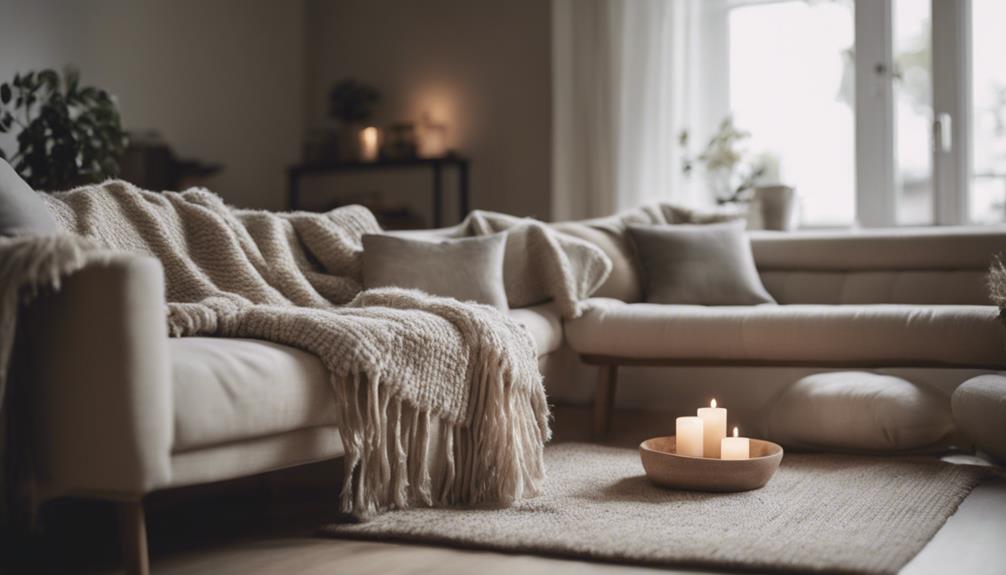
When you're looking to add decorative elements to your space, consider incorporating a handwoven wool tapestry for warmth and texture.
Pair it with ceramic pottery featuring Nordic patterns to enhance that minimalist aesthetic.
Don't forget to showcase framed Nordic landscape artwork, which can bring a touch of nature indoors.
Handwoven Wool Tapestry
Handwoven wool tapestries bring a touch of cultural heritage and artistic flair to your decor, showcasing intricate designs that reflect the craftsmanship of generations. These tapestries often feature geometric patterns, like overlapping triangles and diamonds, inspired by nature and minimalist art. When you choose wool, you're not just selecting a textile; you're opting for a medium with rich historical significance in Scandinavian artistry.
The natural insulating properties of wool make these tapestries ideal for adding warmth and durability to your space. Unlike other materials, wool maintains vibrant colors and patterns over time, ensuring your tapestry remains a striking focal point. Techniques like tapestry weaving enhance the textural quality of wool, creating depth and visual interest that can elevate any room.
As you incorporate handwoven wool tapestries into your home, you're celebrating a tradition that emphasizes local craftsmanship and resource availability. Each piece tells a story, connecting you to the rich tapestry of Scandinavian culture. By choosing wool, you not only enhance your decor but also embrace a legacy of artistry that spans generations.
Let these beautiful tapestries inspire your interior design!
Ceramic Pottery With Nordic Patterns
Incorporating ceramic pottery with Nordic patterns into your decor can beautifully complement the warmth and artistry of handwoven wool tapestries. The geometric designs often found in these ceramics, inspired by nature, reflect the minimalist aesthetic that defines Scandinavian design. You'll notice motifs ranging from folkloric patterns to floral designs, each piece telling a story rooted in the region's cultural heritage.
Brands like Royal Copenhagen and Arabia prioritize high-quality materials and sustainable practices, allowing you to support eco-friendly values while enhancing your home's aesthetic. Many of these pottery pieces aren't just decorative; they serve functional purposes, blending artistry with everyday life.
Consider adding items featuring the diamond twill pattern, which evokes a sense of texture and depth, harmonizing beautifully with the softness of wool. These ceramic pieces can serve as striking centerpieces or subtle accents, drawing attention without overwhelming your space.
Framed Nordic Landscape Artwork
Framed Nordic landscape artwork beautifully captures the essence of Scandinavian nature, offering a striking visual complement to your decor. These pieces often highlight natural themes and geometric patterns, showcasing the deep connection between the region's stunning environments and its textile heritage, including wool.
Many artists integrate traditional weaving techniques into their creations, resulting in unique mixed-media pieces that celebrate cultural heritage. You'll find that the color palettes in these artworks draw inspiration from the breathtaking landscapes, featuring muted tones alongside vibrant hues that evoke the changing seasons.
The use of natural materials in the framing, like wood sourced from local forests, underscores the principles of sustainability and harmony with nature, core tenets of Scandinavian design. By incorporating framed Nordic landscape artworks into your space, you align with the minimalist ethos prevalent in Scandinavian interiors, enhancing the overall serenity and comfort of your living areas.
In essence, these artworks not only beautify your home but also reflect a thoughtful approach to design, making them a perfect addition to your collection of decorative elements.
Flooring
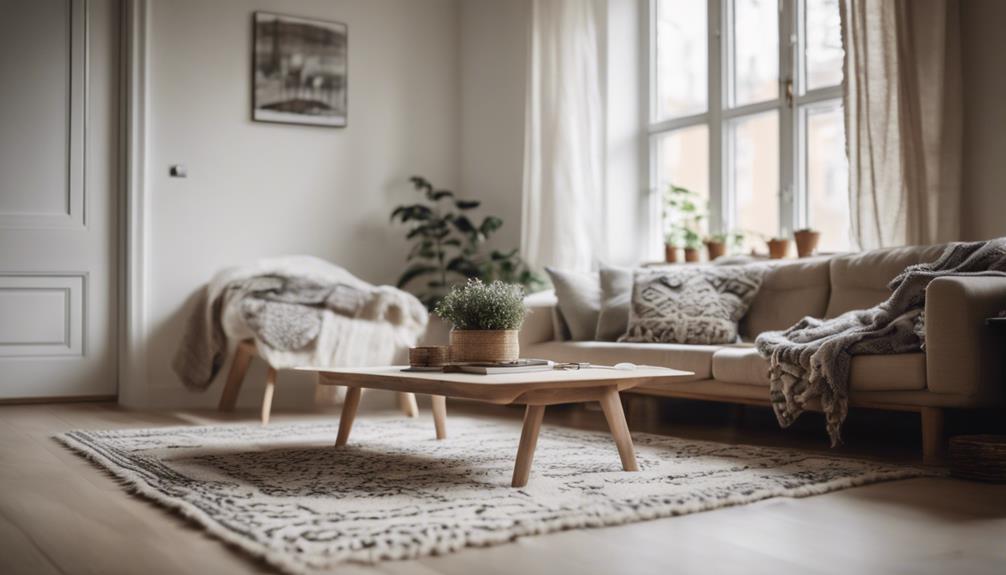
When it comes to flooring, you've got some great options to contemplate.
Reclaimed wood plank flooring adds warmth and character, while natural stone tile brings durability and elegance.
Don't forget about cozy sheepskin area rugs that can enhance comfort and style in your space.
Reclaimed Wood Plank Flooring
Sourcing reclaimed wood plank flooring not only enhances your home's aesthetic but also supports sustainability by reducing the demand for new timber. By choosing reclaimed wood, you're helping to minimize deforestation and promote eco-friendly practices in the flooring industry. Each plank carries unique character marks and patinas, offering a distinct look that adds depth to your interior design.
You'll find that reclaimed wood flooring is typically more durable than new wood. The aging process hardens the wood, making it less prone to warping and damage. Plus, this flooring often contains fewer chemicals, improving your indoor air quality compared to newer manufactured options.
As a bonus, opting for reclaimed wood can add significant value to your home. It's often viewed as a premium product, appreciated for its luxurious appearance and eco-friendly origins. If you're passionate about sustainability, think about how your choice in flooring reflects your values, much like the commitment of producers of wool who focus on ethical practices.
Ultimately, reclaimed wood flooring can enhance your space while making a positive impact on the environment.
Natural Stone Tile Flooring
Natural stone tile flooring offers unparalleled durability and timeless beauty, making it a top choice for enhancing any space. You'll find that there are three types of stone tiles to take into account: granite, marble, and limestone. Each type brings its unique aesthetics, with colors and patterns that can transform your home into a work of art.
Granite is incredibly strong and resistant to scratches, perfect for high-traffic areas. Marble, with its luxurious appearance, adds elegance but requires more maintenance due to its porous nature. Limestone offers a softer look and is ideal for creating a warm, inviting atmosphere.
These tiles are naturally cooler, making them suitable for warm climates and effective underfloor heating systems. However, keep in mind that some stone tiles need sealing to prevent stains and moisture absorption. Regular maintenance is essential to preserve their integrity and beauty.
Investing in natural stone flooring not only enhances your living space but can also increase your property value to a great extent. With their premium appeal, these tiles are a worthwhile investment for any homeowner or designer looking to create a stunning environment.
Cozy Sheepskin Area Rugs
After considering the beauty and durability of natural stone tile flooring, you might find that cozy sheepskin area rugs offer an inviting contrast, adding warmth and texture to your space. Made from the wool of sheep, these rugs provide natural insulation, making them perfect for cold Scandinavian climates. Years ago, people recognized the benefits of sheepskin, and today, its long pile not only feels luxurious underfoot but also helps regulate temperature by wicking moisture away.
Another advantage is their hypoallergenic properties; sheepskin rugs resist dust mites and mold, making them a great choice if you have allergies. You'll appreciate the variety of colors and textures available, allowing you to find the perfect match for your interior design, whether it's rustic or modern Scandinavian.
Moreover, the durability of sheepskin means these rugs can withstand heavy foot traffic, maintaining their appearance with proper care. Investing in a sheepskin area rug isn't just about adding comfort; it's about enhancing your home's aesthetic while ensuring practicality.
Conclusion
When it comes to choosing between wool and linen for your Scandinavian textiles, consider your needs and preferences. Are you looking for a material that is warm, insulating, and has natural water-repellent properties? Then wool might be the best option for you. On the other hand, if you prefer a lightweight, breathable fabric that is perfect for warm climates, linen could be the better choice. Both wool and linen have their unique qualities that can enhance interior design and bring a touch of Scandinavian charm to any space. Ultimately, the decision should be based on what will best suit your lifestyle and the specific needs of your home.
Wool offers warmth and durability, making it perfect for cozy spaces, while linen provides breathability and a crisp look ideal for warmer climates.
Whichever you choose, both materials can beautifully enhance your decor.
Embrace the unique qualities of each fabric to create a stylish, inviting atmosphere in your home.
Happy decorating!





